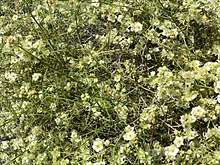Ambrosia salsola
Ambrosia salsola,[3] commonly called cheesebush, winged ragweed, burrobush,[4] white burrobrush, and desert pearl, is a foul-smelling, scraggly perennial shrub in the (sunflower family) common in deserts of the southwestern United States and northwestern Mexico.[5]
| Ambrosia salsola | |
|---|---|
 | |
| Scientific classification | |
| Kingdom: | Plantae |
| Clade: | Tracheophytes |
| Clade: | Angiosperms |
| Clade: | Eudicots |
| Clade: | Asterids |
| Order: | Asterales |
| Family: | Asteraceae |
| Genus: | Ambrosia |
| Species: | A. salsola |
| Binomial name | |
| Ambrosia salsola | |
| Synonyms[1][2] | |
| |
This species easily hybridizes with the white bur-sage (Ambrosia dumosa).[5]
Range and habitat
It is common on sandy desert flats, desert dry washes, and is weedy in disturbed sites in creosote bush scrub, shadscale scrub, Joshua tree woodland, and Pinyon juniper woodland, ranging from Inyo County, California, to northwestern Mexico.[5]
It grows in sandy and gravelly soil, and sometimes on lava formations at elevations of 200–1,800 m (660–5,910 ft).[6][7]
It is native to the southwestern United States (Arizona, California, Nevada, Utah) and northwestern Mexico (Sonora, Baja California, Baja California Sur), where it is a common plant of the local deserts, where it thrives on sandy soil, alkaline environments, and disturbed sites.[4][8]
Growth pattern
It is typically 2' to 3' in height.[5] It drops about half of its leaves and some of its twigs in hot, dry summer conditions (drought deciduous).[5]
Ambrosia salsola is a shrub sometimes attaining a height of 150 cm (59 in).[9][10][10][11][11][12]
This is a perennial shrub which forms a sprawling bush up to eight feet high.[4]
Leaves and stems
It has thin stems and narrow, needlelike leaves. Leaves are narrow and needlelike (linear),[5] thread-like (filiform),[9][10][11] sometimes up to 65 mm (2.6 in) long but a mere 1.5 mm (0.059 in) across.[9][10][11]
The foliage and stem tips have a foul, pungent, cheese-like scent when crushed, a trait which gives the plant the common name "cheesebush".[5]
Inflorescence, fruits, seeds
It flowers from March to June.[5] Numerous small, cuplike male flowers grow in spike-like clusters above the female heads growing in the leaf axils.[5]
All female (Pistillate) flower heads contain only one flower,[4] while all male (staminate) heads may contain 5–15 flowers.[9][10][11]
It is covered in plentiful white or yellow flowers and then pearly, winged fruits in white, yellow, or pink.[4]
References
- Tropicos
- The Plant List
- Mojave Desert Wildflowers, Pam MacKay, 2nd Ed. 2013, p. 314
- Flora of North America Vol. 21 Page 12, Burrobush, Ambrosia salsola (Torrey & A. Gray) Strother & B. G. Baldwin, Madroño. 49: 143. 2002.
- Mojave Desert Wildflowers, Pam MacKay, 2nd Ed. 2013, p. 263
- Flora of North America v 21 p 12.
- CONABIO. 2009. Catálogo taxonómico de especies de México. 1. In Capital Nat. México. CONABIO, Mexico City.
- Biota of North America Program 2013 county distribution map
- Strother, John Lance & Baldwin, Bruce G. Madroño 49(3): 143. 2002.
- Torrey, John, & Asa Gray. 1849. Plantae Fendlerianae Novi-Mexicanae, an account of a collection of plants made chiefly in the vicinity of Santa Fé, New Mexico. Memoirs of the American Academy of Arts and Science, new series 4(1):1-116.
- Forrest Shreve, & Ira Loren Wiggins. 1964. Vegetation and Flora of the Sonoran Desert. Stanford University Press.
- Hickman, J. C. 1993. The Jepson Manual: Higher Plants of California 1–1400. University of California Press, Berkeley.
External links
- Calflora Database: Ambrosia salsola (Burrobrush)
- Jepson Manual eFlora (TJM2) treatment
- USDA, National Forest Service: Ecology of Ambrosia salsola
- Ambrosia salsola in the CalPhotos Photo Database, University of California, Berkeley